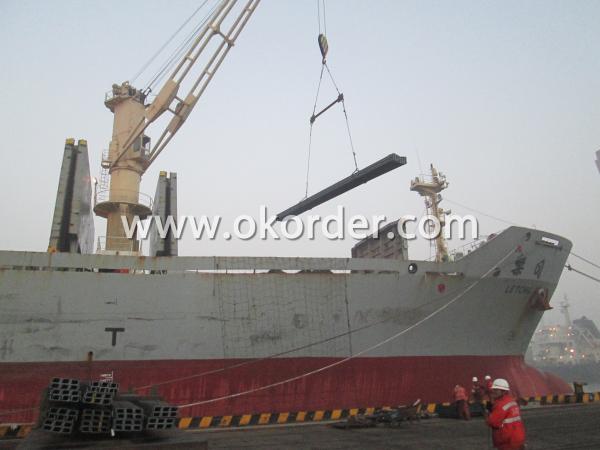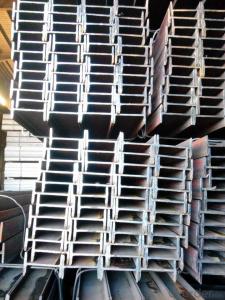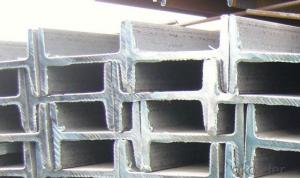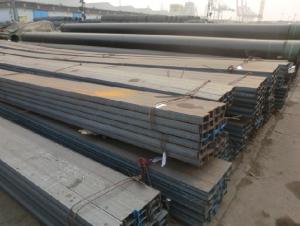European Standard of IPE Beam
- Loading Port:
- China Main Port
- Payment Terms:
- TT or LC
- Min Order Qty:
- -
- Supply Capability:
- -
OKorder Service Pledge
OKorder Financial Service
You Might Also Like
Product Description:
OKorder is offering European Standard of IPE Beam at great prices with worldwide shipping. Our supplier is a world-class manufacturer of steel, with our products utilized the world over. OKorder annually supplies products to European, North American and Asian markets. We provide quotations within 24 hours of receiving an inquiry and guarantee competitive prices.
Product Applications:
IPE/IPEAA Beam Steel are widely used in various construction structures, bridges, autos, brackets, mechanisms and so on.
Product Advantages:
OKorder's European Standard of IPE Beam are durable, strong, and resist corrosion.
Main Product Features:
· Premium quality
· Prompt delivery & seaworthy packing (30 days after receiving deposit)
· Corrosion resistance
· Can be recycled and reused
· Mill test certification
· Professional Service
· Competitive pricing
Product Specifications:
1. Product name: IPE/IPEAA Beam Steel
2. Standard: EN10025, GB Standard, ASTM, JIS etc.
3. Grade: Q235B, A36, S235JR, Q345, SS400 or other equivalent.
4. Length: 5.8M, 6M, 9M, 10M, 12M or as your requirements
<IMG title=IPE/IPEAA style="BORDER-RIGHT: 0px; BORDER-TOP: 0px; MAX-WIDTH: 900px; BORDER-LEFT: 0px; WIDTH: 250px; BORDER-BOTTOM: 0px; HEIGHT: 280px" alt=IPE/IPEAA src="https://file2.okorder.com/prod/2013/11/27/dd95d6a918d1d967216a4cdfdde0000b.jpg" _src="https://file2.okorder.com/prod/2013/11/27/dd95d6a918d1d967216a4cdfdde0000b.jpg">
Section | Standard Sectional Dimensions(mm) | ||||
h | b | s | t | Mass Kg/m | |
IPE80 | 80 | 46 | 3.80 | 5.20 | 6.00 |
IPE100 | 100 | 55 | 4.10 | 5.70 | 8.10 |
IPE120 | 120 | 64 | 4.80 | 6.30 | 10.40 |
IPE140 | 140 | 73 | 4.70 | 6.90 | 12.90 |
IPE160 | 160 | 82 | 5.00 | 7.40 | 15.80 |
IPE180 | 180 | 91 | 5.30 | 8.00 | 18.80 |
IPE200 | 200 | 100 | 5.60 | 8.50 | 22.40 |
IPE220 | 220 | 110 | 5.90 | 9.20 | 26.20 |
IPE240 | 240 | 120 | 6.20 | 9.80 | 30.70 |
IPE270 | 270 | 135 | 6.60 | 10.20 | 36.10 |
<IMG title=IPE/IPEAA style="BORDER-RIGHT: 0px; BORDER-TOP: 0px; MAX-WIDTH: 900px; BORDER-LEFT: 0px; WIDTH: 600px; BORDER-BOTTOM: 0px; HEIGHT: 450px" alt=IPE/IPEAA src="https://file2.okorder.com/prod/2013/11/27/aaec1e0732914ca5c03da5b7c5aa68bb.jpg" _src="https://file2.okorder.com/prod/2013/11/27/aaec1e0732914ca5c03da5b7c5aa68bb.jpg">
Packing & Delivery Terms of IPE/IPEAA Beam Steel
1. Package: All the IPE/IPEAA Beam Steel will be tired by wire rod in bundles
2. Bundle weight: not more than 3.5MT for bulk vessel; less than 3 MT for container load
3. Marks:
Color marking: There will be color marking on both end of the bundle for the cargo delivered by bulk vessel. That makes it easily to distinguish at the destination port.
Tag mark: there will be tag mark tied up on the bundles. The information usually including supplier logo and name, product name, made in China, shipping marks and other information request by the customer.
If loading by container the marking is not needed, but we will prepare it as customer request.
4. Shipment: In containers or in bulk cargo


5. Delivery time: All the IPE Beam Steel will be at the port of the shipment within 45 days after receiving the L/C at sight ot the advance pyment.
6. Payment: L/C at sight; 30% advance payment before production, 70% before shipment by T/T, etc.
FAQ:
Q1: Why buy Materials & Equipment from OKorder.com?
A1: All products offered byOKorder.com are carefully selected from China's most reliable manufacturing enterprises. Through its ISO certifications, OKorder.com adheres to the highest standards and a commitment to supply chain safety and customer satisfaction.
Q2: How do we guarantee the quality of our products?
A2: We have established an advanced quality management system which conducts strict quality tests at every step, from raw materials to the final product. At the same time, we provide extensive follow-up service assurances as required.
Q3: How soon can we receive the product after purchase?
A3: Within three days of placing an order, we will begin production. The specific shipping date is dependent upon international and government factors, but is typically 7 to 10 workdays.
- Q:What are the common deflection limits for steel I-beams?
- The common deflection limits for steel I-beams are typically determined by industry standards and building codes. The deflection limit refers to the maximum amount of bending or sagging that a beam can experience under load without compromising its structural integrity or causing any visual or functional issues. The deflection limits for steel I-beams are influenced by several factors, including the beam's size, span, and the type of load it will be supporting. These limits are usually specified as a ratio of the beam's length to its deflection, known as the L/ (length/deflection) ratio. In general, the deflection limits for steel I-beams can range from L/240 to L/360, depending on the specific application and building codes in a particular region. For example, a commonly used deflection limit is L/360, meaning that the maximum deflection of the beam should not exceed 1/360th of its length. It's important to note that these deflection limits are not only important for ensuring the structural safety of the beam but also to maintain the aesthetic appearance and functionality of the structure. Excessive deflection can lead to issues such as cracking, vibrations, or sagging of floors or ceilings, which can be undesirable in many applications. It is crucial to consult the relevant building codes and engineering standards to determine the specific deflection limits for steel I-beams in a given project. Additionally, it is recommended to work with a qualified structural engineer who can evaluate the specific requirements and provide accurate deflection limits based on the project's design and load requirements.
- Q:What are the different types of steel I-beam support systems?
- There are several different types of steel I-beam support systems commonly used in construction and structural engineering. Some of the most common types include: 1. Rolled I-Beams: These are the most basic and commonly used type of I-beam support systems. They are manufactured by rolling steel plates into the shape of an I-beam, with varying dimensions and load-bearing capacities. 2. Welded I-Beams: These support systems are created by welding together two or more rolled I-beams to form a larger and stronger beam. This method allows for the creation of customized I-beams with specific load-bearing capacities. 3. Composite I-Beams: Composite I-beams are made by combining different materials, such as steel and concrete, to create a stronger and more rigid support system. The combination of materials enhances the overall load-bearing capacity and structural integrity of the I-beam. 4. Box Girders: Box girders are similar to I-beams in shape but have a rectangular or box-like cross-section. They are commonly used when larger load-bearing capacities and longer spans are required. Box girders can be made from steel plates or by welding together multiple sections. 5. Tapered I-Beams: Tapered I-beams have a varying depth along the length of the beam, allowing for more efficient load distribution and weight reduction. These support systems are often used in structures with complex or irregular load requirements. 6. Light-gauge steel I-beams: Light-gauge steel I-beams are made from thinner steel plates and are commonly used in residential construction and smaller-scale projects. They are lighter and easier to handle, but have lower load-bearing capacities compared to heavier-gauge I-beams. These are just a few examples of the different types of steel I-beam support systems. The choice of which type to use depends on factors such as the specific load requirements, span length, and overall structural design of the building or project. It is important to consult with a structural engineer or construction professional to determine the most suitable type of I-beam support system for a particular application.
- Q:Can steel I-beams be used for telecommunications towers?
- Certainly! Telecommunications towers can indeed utilize steel I-beams. Steel I-beams have become a popular choice in the construction industry because of their impressive strength, durability, and ability to handle heavy loads. When it comes to telecommunications towers, which demand sturdy and secure structures to support antennas and equipment, steel I-beams prove to be an excellent option. They possess the necessary strength and stability to endure harsh weather conditions, including strong winds, and can be designed to meet the precise height and load requirements of the telecommunications tower. Furthermore, steel I-beams can be manufactured off-site and easily transported to the tower location, providing a cost-effective and efficient solution for constructing telecommunications towers.
- Q:Can steel I-beams be used for earthquake-prone regions?
- Indeed, earthquake-prone regions can utilize steel I-beams. Steel, being a remarkably ductile material, exhibits exceptional resistance against seismic forces. Specifically, I-beams are renowned for their structural integrity and capability to endure lateral forces generated by earthquakes. The high strength-to-weight ratio of steel I-beams renders them suitable for constructing buildings that can withstand earthquakes. By flexing and absorbing energy during seismic events, these I-beams effectively dissipate the forces acting on the structure, thereby minimizing damage. Furthermore, steel I-beams can be designed and engineered in accordance with specific seismic requirements, guaranteeing the safety of those occupying the building. Nonetheless, it is crucial to emphasize that proper design, construction, and adherence to seismic building codes are imperative to ensure the effectiveness of steel I-beams in earthquake-prone regions.
- Q:Can steel I-beams be used in the construction of amusement parks and entertainment venues?
- Yes, steel I-beams can certainly be used in the construction of amusement parks and entertainment venues. Steel I-beams are commonly used in the construction industry due to their strength, durability, and versatility. They provide excellent support and load-bearing capabilities, making them ideal for structures that require robust frameworks, such as roller coasters, observation towers, and large entertainment stages. Steel I-beams offer several advantages in amusement park construction. Firstly, they have a high strength-to-weight ratio, allowing for designs that can withstand heavy loads while minimizing the amount of material required. This is especially important in amusement park structures, where safety and structural integrity are of utmost importance. Additionally, steel I-beams can be fabricated to precise specifications, allowing for customized designs that fit the unique needs and architectural requirements of amusement parks and entertainment venues. Furthermore, steel I-beams are highly resistant to environmental factors such as corrosion, fire, and pests. This makes them a reliable choice for amusement parks, which are often exposed to various weather conditions and high levels of foot traffic. Steel I-beams can withstand the elements and maintain their structural integrity over time, ensuring the longevity and safety of the amusement park or entertainment venue. In conclusion, steel I-beams are an excellent choice for the construction of amusement parks and entertainment venues. They offer the necessary strength, durability, and versatility required for such structures, providing a safe and reliable framework for the enjoyment of visitors.
- Q:How do engineers determine the appropriate size and type of steel I-beam for a project?
- Through a comprehensive analysis of various factors, engineers ascertain the suitable dimensions and kind of steel I-beam for a project. Initially, they evaluate the project's structural prerequisites, encompassing load-bearing capacity, span length, and expected loads such as permanent (dead) and temporary (live) loads. To establish the necessary size of the I-beam, engineers perform structural computations and apply engineering principles like bending moment, shear force, and deflection analysis. These calculations enable engineers to comprehend the forces and stresses acting upon the beam, facilitating the selection of an appropriate size that can adequately support the anticipated loads without failure. Moreover, engineers consider the type of steel I-beam based on the specific project requirements. Distinct steel grades offer varying degrees of strength, ductility, and resistance to corrosion. Engineers evaluate the environmental conditions, moisture exposure, and potential chemical influences to opt for a steel type that can endure these factors and maintain its structural integrity over time. In addition to structural considerations, engineers also factor in cost-effectiveness and the availability of the steel I-beams. Their aim is to strike a balance between meeting project requirements and minimizing unnecessary expenses. This entails considering the standard sizes and shapes accessible in the market, ensuring that the selected I-beam can be readily sourced and seamlessly integrated into the project without significant delays or additional costs. Overall, the determination of the appropriate size and type of steel I-beam for a project is a meticulous process that demands careful deliberation of the structural prerequisites, load calculations, material properties, and economic factors. Engineers leverage their expertise, knowledge of engineering principles, and relevant design codes and standards to guarantee the secure and efficient utilization of steel I-beams in construction projects.
- Q:What are the different load capacities of steel I-beams?
- The load capacities of steel I-beams vary depending on their size and design. Common load capacities range from a few hundred pounds to several thousand pounds, with larger and heavier beams typically having higher load capacities. It is important to consult engineering specifications and load charts to determine the specific load capacity of a particular steel I-beam.
- Q:Can Steel I-Beams be used for automotive manufacturing facilities?
- Certainly, automotive manufacturing facilities can make use of Steel I-Beams. These beams are widely utilized in construction and industrial settings due to their durability and strength. Within automotive manufacturing facilities, Steel I-Beams serve a variety of purposes including supporting overhead cranes, providing structural support for heavy machinery, constructing mezzanine floors, and creating a sturdy framework for large-scale operations. Furthermore, Steel I-Beams are renowned for their ability to withstand extreme conditions and bear heavy loads, which makes them an excellent choice for automotive manufacturing facilities that handle and assemble heavy machinery and components. In summary, Steel I-Beams offer the necessary strength, stability, and longevity required for the demanding environment of automotive manufacturing facilities.
- Q:What does "I-beam 125A" mean?
- I-beam, also called steel girder, is a long strip steel with cross section.
- Q:How do steel I-beams contribute to a building's overall stability?
- A building's overall stability is enhanced by steel I-beams through various means. Firstly, I-beams are engineered to endure and evenly distribute heavy loads throughout the structure. Their distinctive "I" shape grants them an exceptional strength-to-weight ratio, rendering them ideal for supporting significant vertical loads. Consequently, builders can construct taller and more expansive buildings, confident in the I-beams' capacity to bear the weight without compromising structural integrity. Furthermore, the remarkable rigidity of I-beams renders them highly resistant to bending or twisting. This rigidity guarantees the building's stability even amidst extreme weather conditions or seismic activity. By effectively transferring the load from upper floors to the foundation, I-beams prevent excessive deflection or deformation that could potentially lead to structural failure. Another advantage of steel I-beams lies in their versatility and adaptability. They can be tailored to various lengths and sizes, enabling architects and engineers to design structures that fulfill specific requirements. This flexibility empowers I-beams to span long distances and support sizable openings, such as windows or doors, without the need for additional support columns. As a result, buildings can boast more open floor plans and optimize usable space. Moreover, steel I-beams exhibit excellent fire-resistant properties. Unlike other building materials, such as wood or concrete, steel does not burn or contribute to the propagation of flames. Should a fire occur, I-beams can maintain their structural integrity for an extended duration, affording occupants additional time to evacuate safely. In summary, steel I-beams assume a vital role in ensuring a building's stability by providing strength, rigidity, versatility, and fire resistance. Their capacity to support substantial loads and distribute them evenly safeguards overall structural integrity, making them an indispensable component in contemporary construction.
1. Manufacturer Overview |
|
|---|---|
| Location | |
| Year Established | |
| Annual Output Value | |
| Main Markets | |
| Company Certifications | |
2. Manufacturer Certificates |
|
|---|---|
| a) Certification Name | |
| Range | |
| Reference | |
| Validity Period | |
3. Manufacturer Capability |
|
|---|---|
| a)Trade Capacity | |
| Nearest Port | |
| Export Percentage | |
| No.of Employees in Trade Department | |
| Language Spoken: | |
| b)Factory Information | |
| Factory Size: | |
| No. of Production Lines | |
| Contract Manufacturing | |
| Product Price Range | |
Send your message to us
European Standard of IPE Beam
- Loading Port:
- China Main Port
- Payment Terms:
- TT or LC
- Min Order Qty:
- -
- Supply Capability:
- -
OKorder Service Pledge
OKorder Financial Service
Similar products
New products
Hot products
Related keywords






























